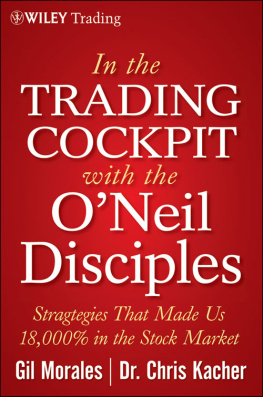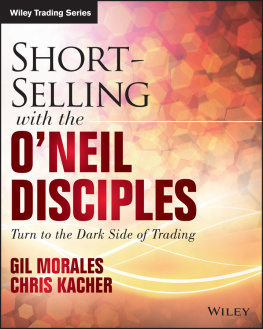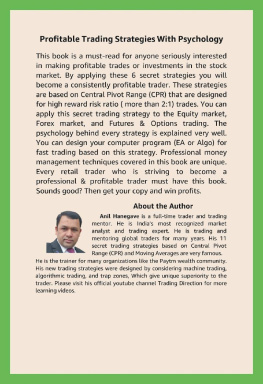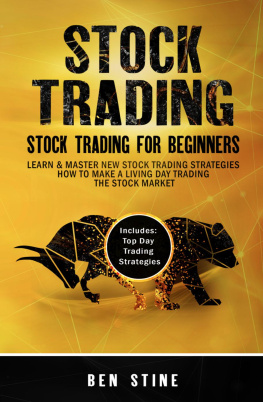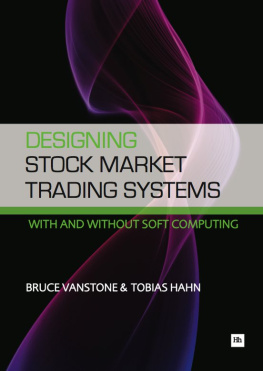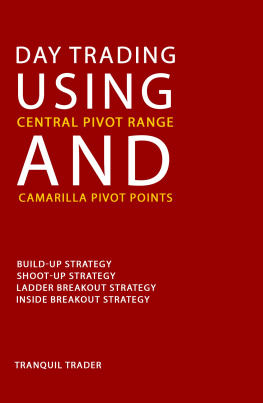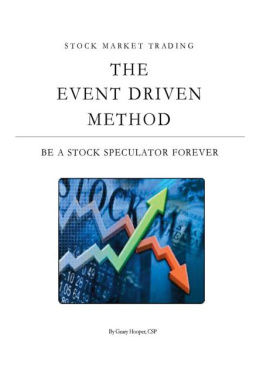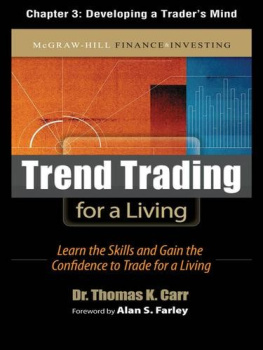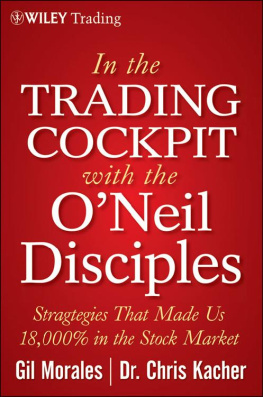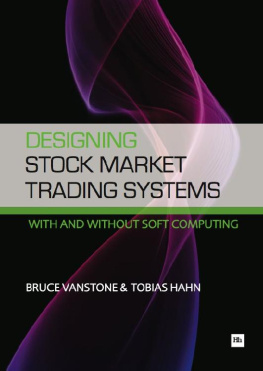
Founded in 1807, John Wiley & Sons is the oldest independent publishing company in the United States. With offices in North America, Europe, Australia, and Asia, Wiley is globally committed to developing and marketing print and electronic products and services for our customers' professional and personal knowledge and understanding.
The Wiley Trading series features books by traders who have survived the market's ever-changing temperament and have prosperedsome by reinventing systems, others by getting back to basics. Whether you are a novice trader, professional, or somewhere in between, these books will provide the advice and strategies needed to prosper today and well into the future.
For a list of available titles, visit our Web site at www.WileyFinance.com .

Cover design: John Wiley & Sons, Inc.
Copyright 2013 by Gil Morales and Chris Kacher. All rights reserved.
Published by John Wiley & Sons, Inc., Hoboken, New Jersey.
Published simultaneously in Canada.
No part of this publication may be reproduced, stored in a retrieval system, or transmitted in any form or by any means, electronic, mechanical, photocopying, recording, scanning, or otherwise, except as permitted under Section 107 or 108 of the 1976 United States Copyright Act, without either the prior written permission of the Publisher, or authorization through payment of the appropriate per-copy fee to the Copyright Clearance Center, Inc., 222 Rosewood Drive, Danvers, MA 01923, (978) 750-8400, fax (978) 646-8600, or on the Web at www.copyright.com . Requests to the Publisher for permission should be addressed to the Permissions Department, John Wiley & Sons, Inc., 111 River Street, Hoboken, NJ 07030, (201) 748-6011, fax (201) 748-6008, or online at http://www.wiley.com/go/permissions .
Limit of Liability/Disclaimer of Warranty: While the publisher and author have used their best efforts in preparing this book, they make no representations or warranties with respect to the accuracy or completeness of the contents of this book and specifically disclaim any implied warranties of merchantability or fitness for a particular purpose. No warranty may be created or extended by sales representatives or written sales materials. The advice and strategies contained herein may not be suitable for your situation. You should consult with a professional where appropriate. Neither the publisher nor author shall be liable for any loss of profit or any other commercial damages, including but not limited to special, incidental, consequential, or other damages.
For general information on our other products and services or for technical support, please contact our Customer Care Department within the United States at (800) 762-2974, outside the United States at (317) 572-3993 or fax (317) 572-4002.
Wiley publishes in a variety of print and electronic formats and by print-on-demand. Some material included with standard print versions of this book may not be included in e-books or in print-on-demand. If this book refers to media such as a CD or DVD that is not included in the version you purchased, you may download this material at http://booksupport.wiley.com . For more information about Wiley products, visit www.wiley.com .
Library of Congress Cataloging-in-Publication Data:
Morales, Gil, 1959
In the trading cockpit with the O'Neil disciples : strategies that made us 18,000% in the stock market / Gil Morales, Chris Kacher.
p. cm. (Wiley trading series)
Includes index.
ISBN 978-1-118-27302-9 (cloth); ISBN 978-1-118-28308-0 (ebk); ISBN 978-1-118-28503-9 (ebk); ISBN 978-1-118-28729-3 (ebk)
1. Stocks. 2. Speculation. 3. Investment analysis. 4. Portfolio management. I. Kacher, Chris. II. Title.
HG4661.M596 2013
332.63'22dc23
2012027374
This book is dedicated to the members of VirtueofSelfishInvesting.com , who have helped us understand what can be misunderstood better than we could have on our own.
To dare is to lose one's footing momentarily. To not dare is to lose oneself.
Soren Kierkegaard
Acknowledgments
This book is filled with charts, and it is the charts that complete the material such that in many ways they are firmly entwined with its essence. We would like to thank Ron Brown, George Roberts, and Ian Woodward of HGS Investor software (highgrowthstock.com) for the use of their wonderful charts throughout the book, as well as the generous folks at eSignal, Inc. ( www.esignal.com ) for the use of their charts and monitor graphics.
We would also like to thank our editors at John Wiley & Sons, Emilie Herman and Evan Burton, for their help and guidance; our publicist, Darlene March, for helping us venture where we might not otherwise tread; Bill Griffith, for always being there to back us up; and those within our respective inner circles who shower us daily with their love and support as they deal with the beasts that we are when we are not out slaying dragonsyou know who you are.
Finally, as is the case with our unique situation, it is important to acknowledge that this book was written and produced with absolutely no assistance, endorsement, or cooperation from William J. O'Neil or any of the O'Neil organizations. This is an independent work.
Introduction
Those who have been trading for at least the past several years have likely experienced the frustration of trying to invest in the mostly sideways, trendless markets of the mid-2000s. Base breakouts were not in abundance as they had been in the 1990s, and most breakouts failed during these trendless years. But one must always take the attitude that what does not kill you only makes you stronger. So it was in mid-2005 that we began seeking answers to the basic conundrum dictated by the fact that we were no longer in the smooth, parabolic-trending market environments of the 1990sthe environment that we grew up in after we began our investment careers in the early 1990s.
Thus began the process of seeking a solution to this conundrum by looking for alternative methods to buying base breakouts in stocks that were becoming obvious to the crowd. Despite the sideways, choppy markets of 20042005, what does not kill you can make you stronger, and the pocket pivot and buyable gap-up concepts were born, concepts created by Chris Kacher (a.k.a Dr K) in 2005 as a result of these challenging markets that were rarely seen in the 1990s. While the pocket pivot and various other permutations of early and alternative buy point techniques were concepts that had been swirling around in the minds of both of us in the mid-2000s, it was Chris Kacher who, through painstaking statistical analysis and the study of thousands of chart examples, finally formalized a set of rules and characteristics that defined these conceptsthus the pocket pivot and buyable gap-up buy points were born, as well as selling strategies embodied by The Seven Week Rule that are designed to keep one in a stock through the fat part of the stock's price move.
One major advantage of using pocket pivots is that it affords one an early entry point within the base of a potential leading stock before it breaks out and hence helps to lower the average cost as you first begin buying and building an initial position in the stock. The lower cost basis gained as a result of getting an early start in buying the stock also translates into a smaller percentage loss if the stock ends up failing on the actual base breakout. The extra cushion gained as a result of initiating a position in a leading stock within the base first and then pyramiding on the actual breakout, as opposed to first entering the stock on the breakout, translates into an additional risk-management edge. Thus if one is stopped out on a breakout failure, the loss is reduced by virtue of having a lower average cost, thanks to starting the position out at an early entry point provided by a pocket pivot buy point occurring at a lower price within the base. In practice, the pocket pivot buy point has proven to be a formidable tool.
Next page
